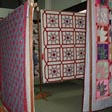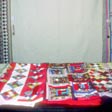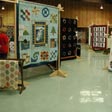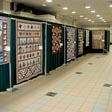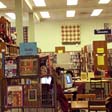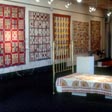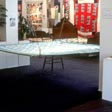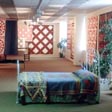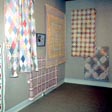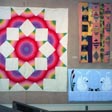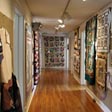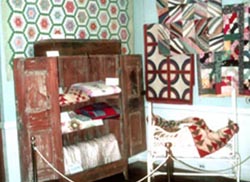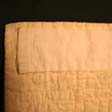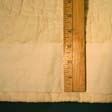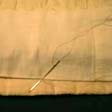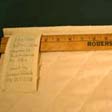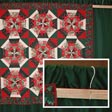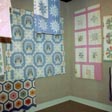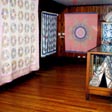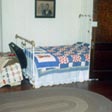Louisiana Quilt Documentation Project -- Exhibiting Quilts
By Susan Roach

Quilt Exhibition Background and Examples
The early 1970s heralded the patchwork quilt as "a great American art form," bringing the rise of quilt exhibitions in museums and galleries, where quilts were analyzed and exhibited as both painting and sculpture. Among the first quilt exhibitions in major museums was the 1971 exhibition, organized by Holstein and Van der Hoof, at the Whitney Museum of American Art, which was also a venue for The Quilts of Gee's Bend exhibition in 2002-03. This new public consciousness of the merit of the quilt as art was raised in part, through feminist articles such as Mainardi's in Ms. magazine and Feminist Art Journal, and Edelson's in Off Our Backs. These works considered the artistic, historical, social, and political aspects of American quiltmaking, suggesting that quiltmakers had been ignored in the art world because quilts were basically a woman's art form. Since the 1970s, quilt exhibitions have multiplied in both major and smaller museums and galleries. These institutions, along with communities, have learned that quilt exhibitions are a sure means of bringing in larger, more diverse audiences.
However, museums were not the first to exhibit quilts; women's groups have been displaying and even judging their quilts since the early days of state, regional, and church fairs and bazaars. Often these local community quilt exhibit events are quickly organized and casually displayed, lasting one to three days. Regional, parish, and state fairs have offered quilt competitions for ribbons and prizes, yet the quilts may be displayed with other crafts (Figure 1). A community exhibition may display the quilts for one day with the quilts spread over chairs sitting on tables (Figure 2), or they may use a variety of racks, wall hanging, and tables, as the 2004 Claiborne Jubilee Quilt Show in Homer, La. (Figure 3), or the 2001 Pork Fest Quilt Show in Bernice (Figure 4).
Today contemporary quilting guilds continue the quilt show tradition on both local and national levels. These shows are usually up for one to three days. A number of North Louisiana guilds have regular shows of their members' works. For example, the Heritage Quilt Guild, located in Jonesboro, has a bi-annual show (Figure 5), and the North Louisiana Quilters Guild, based in Monroe, has an annual show (Figure 6). The Piney Hills Quilt Guild, of Ruston, has occasional shows in such venues as the parish library (Figure 7).
In Louisiana, numerous museums and galleries have held long-term quilt exhibits, lasting one to three months. One of the first museum quilt exhibitions in North Louisiana, Patchwork Quilts: Deep South Traditions was held at the Alexandria Museum in 1980, guest curated by Susan Roach. This exhibition presented quilts in process in the quilting frame, on the walls, and on beds (a good way to exhibit older, fragile quilts) The exhibition also featured photos of the quilters beside their quilts (Figures 8, 9).
This type of exhibition format became popular in the 1980s and continues today in Louisiana galleries and museums, such as the Louisiana Tech University Art Gallery in 1981 (Figure 10), Meadows Museum of Art in Shreveport in 1988 (Figure 11, 12) and the Masur Museum of Art in Monroe in 1998, and smaller museum such as the Snyder Museum in Bastrop in 2002 (Figure 13).
Exhibition Considerations
Institutions or communities interested in exhibition quilts must consider a number of factors for a safe, successful exhibition:
Security of the exhibition: Since quilts have both sentimental and high market value, it is important to make sure that the quilts can be monitored in the exhibit space and cannot be taken out of the space or damaged while on display. If available, stanchions (or wide ribbon or ropes) can be used to distance viewers from the quilt, and provide additional security. Ideally, exhibition monitors or docents should be present in each room or gallery where quilts are displayed, reminding viewers not to touch the quilts; do not touch signs can also be posted. Handling the quilts is damaging since oils from skin build up and will discolor the quilts over time. White cotton gloves can be provided for docents and for viewers wanting to see the backs of quilts. When monitors are not available, the space should be locked securely.
Duration of the exhibition: Since hanging a quilt exposes it to stress from hanging and lighting, long-term exhibitions are not recommended. Quilts can be more safely exhibited from one to three months. Short-term exhibits from one to three days may call for less time-consuming methods of hanging, such as draping over rods, quilt display racks, etc.
Lighting: Quilt colors are subject to fading, so special care should be taken to avoid exposing them to direct sunlight (through windows) or fluorescent lights for long term exhibition.
Insurance and loan/claim forms: Usually, museums and galleries have loan forms and insure each quilt that is displayed; however, small community exhibits may have not considered the need for loan forms, and may not be able to provide insurance for quilts left in their care. In this case, lenders to the exhibition or show should be made aware of this up front in writing on a loan form. This form can be used to collect information on the lender, quilt, and quiltmaker. The form should have a claim stub for retrieving the quilt as well (see sample form).
Interpretive information: Quilts on exhibit are much more meaningful if contextual information is provided with the quilt. For long-term exhibitions, this could include a photograph and biography of the quilter, an artist's statement, stories about quilt and its history, as well as details on the materials, size. The basics of this information can be collected from the owner when the quilt is borrowed (see above loan form). More detailed information can be collected on the Louisiana Quilt Documentation Form. Curators can word process appropriate information from the forms, and print cards or larger interpretive panels to be posted beside each quilt. Viewers are especially interested in the story of the quilt's history and the process of its making.
Handling quilts: Given the weight of the patchwork quilt with its multi-layers, it is essential to handle it carefully. Clean tables, preferably covered, should be available to examine the quilt to see if it is strong enough for hanging. Tables can also be used to rest the quilts while preparing them for exhibition. Quilts should be carried carefully by draping them over both arms. When installing the quilts, two or three people are needed to hold the weight of the quilt until it is securely fastened to the wall or other hanging apparatus. It is best if exhibit installers can wear white gloves, but if not, hands should be washed thoroughly and often to avoid soiling the quilts.
Display Methods: Quilts may be displayed horizontally (flat, draped, folded, etc.) or vertically on walls in various ways. The condition of the quilt should be considered in choosing the display method.
Horizontal display: Ideally, quilts are displayed with the top (front) of the quilt displayed fully spread; however, because of their size, this may not be feasible. The age and condition of a quilt will determine the manner in which it may be displayed, so each quilt should be examined carefully to determine if it is strong enough for hanging. Older antique quilts, especially with fragile fabrics such as silk should not be hung on the walls. The least stressful method of exhibiting a quilt is flat on a historic bed, which provides good support. In fact, it is a good idea to have a quilt displayed on a bed to remind viewers that this is the original use of the quilt. Or a flat support place on an incline can be built to hold the quilt and will provide good support for the whole quilt, although this may not be the most dramatic. Other methods include draping over pieces of furniture such as quilt racks or chairs or in cabinets (Figure 14).
Vertical display: The preferred method of hanging on the wall uses a temporary sleeve stitched along the length of the back of the quilt. The sleeve should be made from well-washed unbleached cotton muslin (or a very well-washed white sheet) (Figure 15). Usually, the muslin sleeve is six inches wide and as long as the side of the quilt; consider the wall space and the top design when deciding on which side to attach the sleeve. The finished sleeve should be wide enough for a dowel, rod, or lattice strip to be run through it (Figure 16). To stitch the sleeve to the quilt, make sure the quilt is supported on a flat surface, and stitch the sleeve to the back of the quilt only. The stitches should not go through the front (top) of the quilt. The top edge of the sleeve should be placed about a half inch below the top of the quilt. The sleeve should be stitched with a blind stitch across the top and bottom folds of the sleeve (Figure 17).
A less common alternate method for very short-term exhibits uses a series of unbleached muslin tabs or loops stitched at intervals across the back edge of the quilt (Figure 18); however, this distributes more weight over less area of the quilt, which is more stressful over parts of the quilt. Therefore, the whole sleeve method above is much better. It is a good idea for each quilt to have some identifying information attached to it. The best method is to have it stitched on by the quilter; however, the owner's name and quilt identification can also be penciled on the sleeve or tab; attaching with pins is not recommended.
Hanging hardware: One-inch dowels and lattice strips should be sanded and sealed with paint, shellac, or polyurethane well in advance of their use so that they are completely dry. The dowels can be hung on the wall by attaching picture wire or monofilament on the ends of the rods and tying it to picture hanging hardware (or strong nails). Be sure the hardware or nails are strong enough to support the weight of the quilt. Some quilt guilds such as the Cotton Country Quilters, in Monroe, La., who hold weekend exhibits in civic centers have been using the booth hardware poles and drapery to hang their quilts and have devised clever ways of hanging sleeved quilts with lattice strips (Figure 19).
If the pattern of the quilt top is a repeated one, the quilt can be folded for display and draped over a dowel or rod, which can be hung on the wall (Figure 20). It is best to cover the part of the dowel that is in contact with the quilt with well-washed, unbleached cotton muslin (or a well-washed white sheet).
Other methods: Some other more recent methods of hanging quilts have been used, but are not highly recommended. One method uses Velcro instead of a sleeve. The soft Velcro is stitched to the back of the quilt, and the loop side is put on the wall. The Velcro does distribute the weight well, but is harder to stitch to the quilt and may contain acid. Also, placing quilts between glass is not recommended by most conservators since it may allow condensation, which can grow mold. There are some additional methods using wood pieces put together to hold the quilt through pressure; however, these are expensive and if used for a long-term exhibit, will compress the quilt fibers.
Exhibition Installation Themes: If a community show or museum exhibition must exhibit a large number of quilts, some attention should be given to the arrangement of the quilts. Successful exhibitions have used different organizational principles to group the quilts, such as color, chronology, pattern types, quilters, etc. For example, when the Lincoln Parish Museum held a quilt exhibit, A Century of Quilts, to celebrate the centennial of Ruston, one hundred quilts were shown in the small museum in various rooms already containing historical artifacts and cases. Both color and historical groupings were used throughout the museum to accommodate the large number of quilts (Figures 21, 22). One room was devoted to the red and green quilts from the 19th century.
Ultimately, it is best to remember that while quilts may seem sturdy, they can be damaged through long-term exhibition exposing them to light and the stress of gravity. But no exhibition of artifacts can top the beauty and popularity of a well-interpreted, carefully installed quilt exhibition.
References
Edelson, Carol. "Quilting: A History." Off Our Backs. May 1973: 13-14.
Holstein, Jonathan. The Pieced Quilt: An American Design Tradition. Greenwich, Connecticut: New York Graphic Society, 1973.
Mainardi, Patricia. "Quilts: A Great American Folk Art." Ms. Dec. 1973:58-61+.




